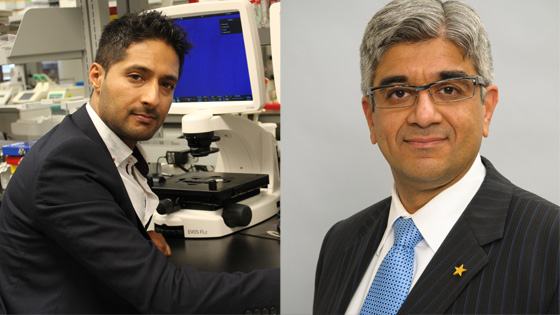
Drs. Mohit Kapoor and Nizar Mahomed combine their expertise in arthritis research and treatment to help readers understand the disease and the treatments available. (Photo:UHN)
September is Arthritis Awareness Month. Osteoarthritis (OA) is the most common form of arthritis and affects one in 10 Canadians.
Drs. Mohit Kapoor and Nizar Mahomed wanted to distill the sea of information available on OA into a single resource that provides an in-depth look at key aspects of the disease, from how it starts to the latest research being tested in human clinical trials.
Their book,
Osteoarthritis: Pathogenesis, Diagnosis, Available Treatments, Drug Safety, Regenerative and Precision Medicine, compiles the opinions of global experts in the field and is written in a style that is accessible for patients and relevant for those with an interest or expertise in the field of medicine.
"Patients in their 50s and 60s are living much more active lifestyles and show no sign of slowing down until they are hit with the joint pain and stiffness that makes activities increasingly difficult and eventually impossible," says Dr. Mahomed.
"My goal is to get them back to skiing, bike riding, hiking – whatever it is they love doing – as quickly as I can."
OA occurs when the cartilage in the joints wears away and inflammation occurs. Cartilage provides the cushion between the joints that allows you to have a fluid and smooth range of motion – inflammation causes swelling, stiffness and pain. Over time painful bone on bone contact can seriously impact a person's mobility and quality of life.
Understanding treatment options
Dr. Kapoor, who heads the Cartilage Biology and OA Biomarker research, oversees the Osteoarthritis Research Programs' basic science initiatives at UHN's Buchan Arthritis Research Centre. As a scientist and professor, he is focused on translating basic arthritis research into new treatments for arthritis patients.
Complimenting Dr. Kapoor's research expertise is Dr. Mahomed, an orthopedic surgeon and Director of the UHN Arthritis Program. He brings both the perspective of the patient and the surgeons who hope to find alternatives to joint replacement surgery in the near future.
The book covers all the major joints such as the knee, hip, shoulder, elbow, ankle, hand, wrist, and spine affected by OA. Depending on which joint is affected, recently diagnosed patients can read about how the disease is identified, the assessment process, as well as treatment options, which include surgical interventions.
Are we there yet?
The book also offers several chapters on the use of medical imaging, biomarkers, regenerative medicine and precision medicine – treatment that will be available in the not-so-distant future.
The potential for using a
person's own stem cells to combat the loss of cartilage is very promising and could one day eliminate the need for joint replacement therapy.
"Anyone who is living with Osteoarthritis or who specializes in this area of medicine now has a go-to guide to help make sense of the information available," says Dr. Kapoor.
"This book provides a common ground for both doctors and patients to learn about osteoarthritis and a jumping off point to discuss the best treatments or management options we have available."
Osteoarthritis: Pathogenesis, Diagnosis, Available Treatments, Drug Safety, Regenerative and Precision Medicine can be purchased on
Springer.com and
Amazon.ca.
